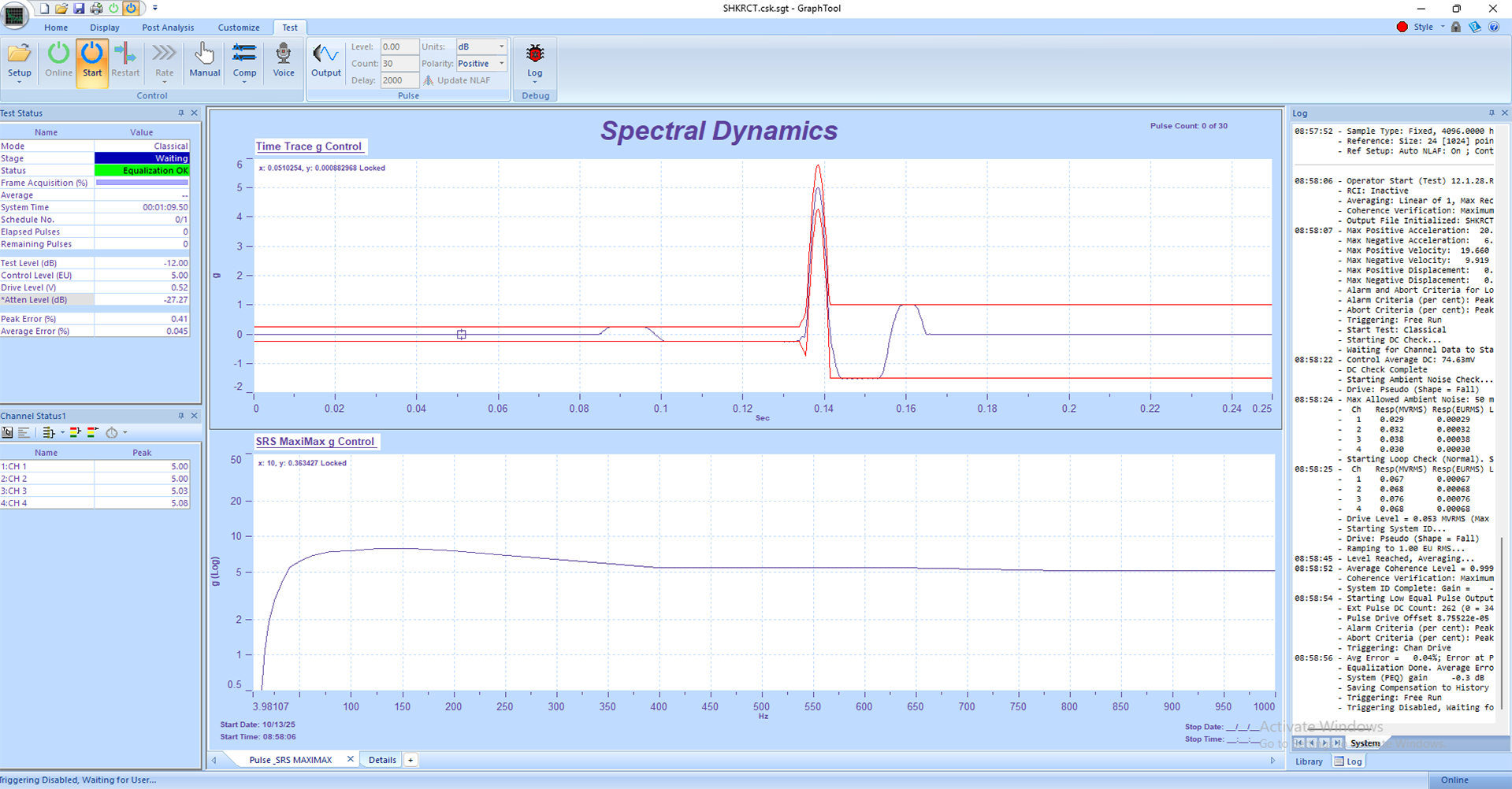Shock
Panther Shock Control delivers precision and performance in transient vibration testing. Built on Spectral Dynamics' heritage as the inventor of closed-loop digital vibration control, Panther combines advanced adaptive algorithms, comprehensive safety, and intuitive operation to provide trusted results, every time. Panther Shock Control delivers the accuracy, repeatability, and safety required for critical transient testing, providing advanced waveform synthesis, adaptive equalization, and real-time protection systems that ensure safe and accurate shock reproduction — every time. When quality of data is important, Panther sets the standard.

Ease of Use & Flexibility
Panther's Shock application simplifies even the most complex transient test setups. Through the Library feature, users can instantly access saved setups, data, and reports without navigating complex file paths. The intuitive interface provides instant recall of setups and data, supports Classic Shock, SRS Shock Synthesis, and Shock Response Analysis in one application. Real-time graphical visualization of input and output waveforms enables immediate feedback, while automatic report generation with overlaid comparison plots streamlines documentation. The simple setup workflow is designed for minimal operator interaction, and the interface supports touch-screen operation on Windows PCs and tablets. Easily and quickly compare data from different channels and different test runs. Panther's modern, touch-friendly interface makes operation fast and intuitive, for engineers at all experience levels.
Advanced Shock Control Technology
• High-Resolution Acquisition — With simultaneous sampling across all channels at up to 262,144 samples per second and 24-bit ADC resolution, Panther accurately captures even the fastest transients and high-frequency components required for SRS and classic shock testing.
• Gap-Free Data Streaming — Real-time, gap-free recording of every test run directly to disk for complete post-test analysis.
• Multiple Data Streams — Independent sample rates per input and control stream for efficient and optimized data capture.
• Classic Shock Control — Generates and controls traditional transient pulses (half-sine, sawtooth, trapezoidal, etc.) with precision and repeatability.
• SRS Shock Synthesis — Produces complex waveforms matching a user-defined Shock Response Spectrum (SRS) using specific linear-phase synthesis filters for accurate reproduction.
• Adaptive Equalization — Proprietary real-time correction algorithm compensates for hardware and fixture response without iterative tuning.
• Waveform Preview & Verification — Preview synthesized waveforms and automatically verify response before execution to ensure test accuracy.
• Multi-Event Sequencing — Combine multiple shock events within one test for increased test realism and efficiency.
• Data Comparison — Overlay live and reference waveforms for pass/fail validation and instant verification.
• Automatic NIST-Traceable Calibration — Ensures measurement accuracy for both input and output channels with internal digital calibration.
• Full Channel Synchronization — Maintains precise phase alignment across all channels (< 1 µs) for accurate multi-axis testing.
• Powerful Library System — Provides fast access to setups and data with aliasing and favorites for instant recall of test configurations.
Safety and Reliability
Panther continuously monitors the signal path and hardware health during every shock event. Over-level aborts, slew-rate limits, and redundant safety relays protect both the test article and control system. Built-in watchdogs, automatic abort thresholds, and real-time feedback ensure operator and equipment safety. Panther monitors over a dozen critical parameters up to 25 times per second. Safety isn't an afterthought — it's designed into the system.
Applications
Aerospace • Automotive • Defense • Electronics • Transportation • Energy
Technical Data Sheet
|
Input Subsystem |
Output Subsystem |
|
Input Channels: 8 channels (expandable up to 32) |
Dynamic Range: >110 dB |
|
Dynamic Range: >110 dB |
DAC: 20 Bit |
|
ADC: 24 Bit |
Max Output Amplitude: ±12 V Peak |
|
Voltage Ranges: ±12 V to ±0.5 V in 8 steps |
Max Output Current: 16 mA |
|
Auto Ranging: Yes |
Amplitude Accuracy: ±0.20% of value or ±0.03% of full scale (whichever is greater) |
|
Overload Detection: Full scale on all channels; analog and digital detection |
Amplitude Linearity: ±0.20% of value or ±0.03% of full scale (whichever is greater) |
|
Voltage Coupling: AC or DC or GND |
Max Attenuator Rate: Software selectable |
|
IEPE Power: 4 mA (24 V max into open circuit) |
Max Output Rate: 262,144 samples per second |
|
Max Rated Input Signal: ±35 V Peak |
Image Attenuation: <96 dB |
|
Max Sampling Rate: 262,144 samples per second |
Frequency Accuracy: ±5 ppm |
|
Sampling Interval: Simultaneous on all channels |
Freq. Range Reduction: 10-stage smoothing filters |
|
Frequency Accuracy: ±5 ppm |
Reconstruction Filters - Analog: Cutoff: 1 kHz, 10 kHz, 25 kHz, OFF; Image Attenuation >96 dB; Pass Band Ripple ±0.15 dB |
|
Freq. Range Reduction: Digital decimation and filtering using on-board FPGA and DSP |
Output Offset Removal: Digitally controlled; Accuracy ±0.5% of Full Scale |
|
Anti-Aliasing Filters - Analog: Fixed @ 524 kHz; Alias Attenuation >105 dB; Pass Band Ripple ±0.10 dB |
Output Impedance: 60 Ω |
|
Anti-Aliasing Filters - Digital: Variable; Stop Band Attenuation >96 dB @ Nyquist; Pass Band Ripple ±0.15 dB |
COLA Output Level: 1 V Peak (generated after analog smoothing filter) |
|
Channel-Channel Match (Single Unit): Amplitude ±0.25 dB; Phase ±1.0° to 100 kHz |
Output Type: Pseudo-differential; 10 Ω to system ground (low side return) |
|
Channel Crosstalk: <-100 dB |
Output Cable: Drives up to 50 ft of shielded 50 Ω coaxial cable |
|
Phase Between Units: ±1.0° to 100 kHz |
|
|
Offset Removal (Input): Digitally controlled; Accuracy ±0.5% of full scale for each input range |
|
|
Input Impedance: 1 MΩ |
|
|
Connector Type: BNC |
|
|
Connection Type: Pseudo-differential, 10 Ω to system ground (low side return) |
|
|
Calibration: Internal digital calibration, NIST referenced |
|
|
Calibration Constants: Digital calibration constants stored in ASCII file |
|
|
Host to Unit Communication: USB or Ethernet or Optional Wi-Fi |
|
|
TEDS Compliant: Yes |
|

